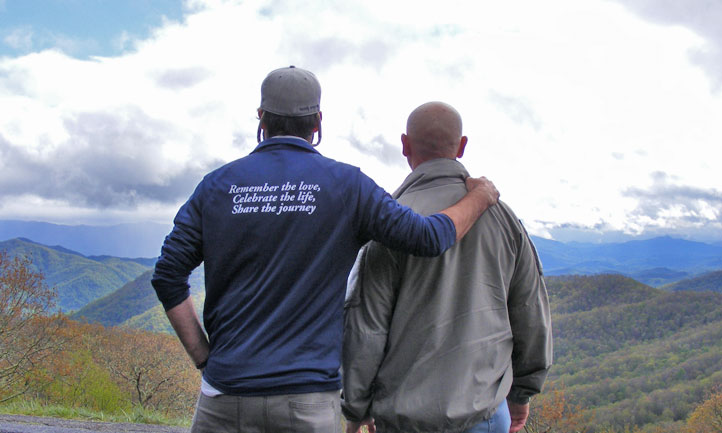Let It R.A.I.N.
Author: Heather Stang
As a child, I dreaded overcast days, especially during the summer. Even when it wasn’t raining, the threat of precipitation felt like a life sentence with no chance of parole. It was the grey skies I feared, even though they would often lead to bluer skies and sometimes a rainbow.

Living in emotional pain is a lot like bad weather. There is no control, no predicting when the clouds will come or when the rain will start. But we can learn to relate to our pain differently, softening our resistance and recognizing it as something other than the enemy.
Pain is a signal that we need emotional, physical or spiritual care. And our normal reaction is to try and ignore it, either to be “strong” or in hopes that it will just go away. Somehow, we instinctively feel that ignoring will somehow make it hurt less. Oftentimes, emotional pain that comes with grief can be overwhelming, and we usually have no idea how to tend to our difficult feelings.
While avoiding and numbing might bring short-term relief, one researcher quipped, “Emotions that are ignored just go down into the basement to lift weights.” When we resist unavoidable pain, we just cause more. Have you ever tried to suppress your tears, or pretend you’re happy when you aren’t? Even if it feels better in the moment, it will come back. The pressure of pretending will add to your sadness, and make everything worse.
One of the most useful self-care techniques I know is called R.A.I.N., based on four steps to bring about mindfulness. Meditation teacher Tara Brach explains in her book, “True Refuge,”that R.A.I.N. allows us to “direct our attention in a clear, systematic way that cuts through confusion and stress.”
When we are faced with pain and unsure what to do, this step-by-step process encourages self-kindness and compassion that can reduce fear, bringing us stability and eventually more long term relief.
How to Practice R.A.I.N.
R.A.I.N. can be practiced as a planned, seated meditation or whenever a difficult emotion arises during daily life. The first time you practice R.A.I.N., try it out on a mild frustration or irritation. If you’re concerned the practice may become overwhelming, try it with a friend or in a group.
RECOGNIZE What You’re Feeling
Initially, we must recognize that we are suffering - simply naming the difficult emotion is crucial. Speaking silently to yourself, acknowledge your feeling with words. “Sadness, sadness.” Or, “Anger, anger.” Or, “Guilt, guilt.” Keep your tone soft and gentle as you validate your truth with kindness, rather than ridicule or judgment.
ALLOW the Feeling to Unfold
Our natural human tendency is to either run away or become overwhelmed by difficult emotions. We must choose to experience the feeling and allow it to unfold naturally - not trying to fix, change or adjust it. You have to allow yourself to experience pain. You are in pain because you have lived and loved. That’s what pain means. Try to remember that pain is not the enemy, but a representation of something beautiful you had.
This radical act of self-compassion allows us to loosen our resistance and soften into our truth.
INVESTIGATE the Emotion with Kindness
How do we face the truth of suffering without becoming overwhelmed? We add in the element of mindfulness – using our senses rather than our thinking mind to investigate our experience.
Instead of fixating on what triggered your emotion, observe how the emotion is manifesting.
Investigate the emotion. Notice the physical properties of the emotion. Where do you feel the emotion in your body? How much space does the emotion take up? What is its shape? Does it feel hot, or cold, or somewhere in between? If it had a color, what color would it be? Is it solid or spacious? Does it throb, pulse or move, or is it resting and still?
Investigate your body. Connect with your breath, allowing your inhales and exhales to come and go naturally. What is happening in the rest of your body? If you felt the difficult emotion in your chest, notice the sensations in your arms, legs, back and shoulders, and face. When you find areas that are tense, see if you can consciously relax them a little.
Investigate your body as a whole. Feel the sensation of your whole body, including the area of strong emotion. Simultaneously, feel the sensation of your breath.
NON-IDENTIFICATION, NOURISH With Self-compassion
Mindfulness teacher Sharon Salzberg explains in “Real Happiness” that non-identification is acknowledging that what “you’re feeling today isn’t your whole resume, the final word on who you are and who you’re going to be. Instead of confusing a temporary state with your total self, you come to see that your emotions arise, last a while and then disappear. You feel some fear, and then you don’t. You’re resentful, and then you aren’t.”
Also, nurture yourself with self-compassion and self-care. Ask yourself what you need. And then give yourself the answer. Take time to treat yourself as a beloved friend, whether you choose to simply offer yourself words of kindness, pray, reach out to a TAPS Peer Mentor or embark on a self-care journey. There is no right or wrong, as long as you are being kind and true to yourself.
There is no fix to pain, but working through it is a process. Try to let go and go through it when you are ready. After the rain, there can be occasional blue skies.
Try R.A.I.N. Visit mindfulnessandgrief.com/grief-emotions.
By Heather Stang: Heather is the author of Mindfulness and Grief, and facilitates the online companion program, Transform Your Life After Loss with Meditation, Movement and Journaling. She holds a Master’s Degree in Thanatology and is a Certified Yoga Therapist. Heather is the founder of the Frederick Meditation Center and runs MindfulnessAndGrief.com.
